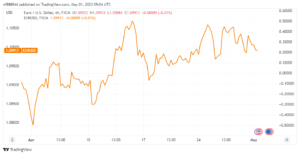The EURUSD has begun the new week under moderate negative pressure, falling below the 1.1000 level. The pair is facing a critical near-term support level of 1.0975. The pair’s activity might stay muted ahead of the ISM Manufacturing PMI data from the US. With trade conditions continuing light in Europe owing to the Labor Day vacation.
Prior to the weekend, US statistics indicated that the Employment Cost Index. Which measures compensation expenses for civilian workers, climbed by 1.2% in the first quarter. This number came in above the market consensus of 1.1% and follows a 1% growth. In the previous quarter. Following this data, the US Dollar (USD) remained resilient against its rivals. Preventing EURUSD from gaining recovery momentum.
The ISM Manufacturing PMI for April will be included in the US economic calendar.
The ISM Manufacturing PMI in the United States is expected to rise to 46.6 in April from 46.3 in March. The survey’s inflation component. The Prices Paid sub-index, is predicted to rise over 50 and enter growth territory.
Investors may choose not to react to the ISM report ahead of the US Federal Reserve’s policy comments on Wednesday. Nonetheless, a larger-than-expected rise in the headline PMI combined with. A strong inflation reading could help the USD gain strength, at least initially, and vice versa.
EURUSD Technical Analysis
On Monday, EURUSD is trading at 1.1000, where the 50-period Simple Moving Average (SMA) is placed. The 100-period SMA, at 1.0975, works as a major support level just below that level. Buyers have defended this level multiple times in the last two weeks.

Moreover a four-hour closing below 1.0975 might open the door to more losses, with the pair eyeing 1.0900 (psychological level, 200-period SMA) as intermediate support.
On the upswing, 1.1025 (20-period SMA) serves as the initial resistance level, followed by 1.1050 (static level) and 1.1100 (2023-high, psychological threshold).









